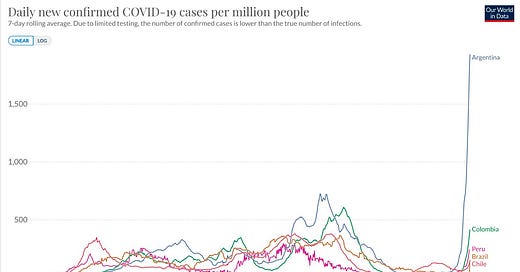The Omicron Wave will disrupt Latin America
The next three months are going to bring disruptions to businesses and governments.
Last week I wrote that the pandemic will be over after the Omicron wave passes, at least from a political and economic point of view. Of course, that means that we still need to get past the disruption of Omicron first. Today’s newsletter discusses the disruptions that are likely to be seen in the coming weeks around Latin America.
Argentina on this graph is everyone else’s future line. For countries that don’t report this sort of surge in the coming three months, it’s most likely a sign that they are lying about their statistics or lack the testing capabilities.
There will be lying about statistics and data disputes. Brazil paused some of its statistics over the past month, meaning that readings on that country’s Omicron surge aren’t being fully captured by the chart above. Mexico has had poor reporting throughout this pandemic and is now encouraging people to avoid testing unless they are in high risk groups.
Most governments will not impose severe restrictions. They can’t afford to do so either economically or politically. They’ve learned lessons from earlier in the pandemic that closing everything, especially schools, is not the correct solution. And the few things they should consider closing (i.e. indoor dining) seem to be untouchable for political reasons - no politician wants to be blamed for the economic and social disruption it would cause.
(The fact most politicians will happily close schools long before they consider closing indoor dining again says a lot about political power and influence).
In the few places where restrictions are imposed, they will have limited impact in terms of mitigating the virus. Omicron is more contagious than previous waves and the region’s citizens are no longer as vigilant about following government orders. While moderate restrictions may be reasonable in some cases, there should also be concerns that restrictions when they occur will be too harsh, too long, and unevenly enforced in a way that harms poor and marginalized populations.
With the Omicron wave hitting the US a few weeks ahead of the virus in Latin America, the region should be watching the US and preparing. While nothing I write in the next paragraph will surprise people currently living with this in the US, my general sense from conversations and media monitoring around Latin America is that most people, businesses and governments in the region have not recognized how disruptive the upcoming wave will be in the coming weeks.
Even without government restrictions, at its worst moments in the coming weeks, there will be temporary disruptions due to everyone getting sick in a single business or location. Classrooms will run out of teachers. Restaurants will run out of cooks and servers. Hotels will run out of front desk staff. Security guard services will not have enough trained guards. Airlines are already seeing flight cuts in the region and more flight cancellations will occur in the coming weeks. Those disruptions may only last a few weeks once they hit any specific business, but they’ll be felt by anyone who encounters them.
The region will likely see political leaders getting covid again (see my July 2020 post on the topic for analysis plus a picture of Bolsonaro being bitten by an emu). Mexico’s president announced he is COVID positive for the second time last night. While presidents and prime ministers will make headlines, cabinet ministers, governors, and mayors are also likely to get hit hard during the next wave.
The region does not have many big events coming up in the next three months, but the Omicron wave could seriously disrupt Costa Rica’s election. The government is unlikely to postpone the election (though it’s possible), but the wave could create serious logistical challenges for voters and election workers. Colombia’s legislative elections in March will likely occur as the wave subsides. By the May presidential election in Colombia and the upcoming Summit of the Americas, the wave should be totally done.
Thanks for reading
If you want to support this newsletter and receive additional content, please consider subscribing.




Some pushback here. I'm in Argentina right now, and I know people who run a large suburban testing center. I'm also therefore in contact with the people who run a large suburban jurisdiction. Omicron is very widespread and it is astonishing the number of people I know who have gotten or are getting sick ... yet there is really very little effect. Testing is coping, there are no shortages, public services are running despite higher absenteeism. Bars and restaurants have not been affected in any noticeable way. The number of ICU patients is running well below the previous peak.
So either we haven't yet seen peak effects or I am missing something vital. Help me out? Because right now this wave is not seeming particularly disruptive.